If you have an aquarium and you are like me, you want your water to be as clean and clear as possible. Diatom filters are a great way get your water sparkling, without affecting the water chemistry.
What is a diatom and why does it make such a great filter media? Diatoms are tiny (10-200 microns) algae that grow in a myriad of shapes. When they die, their silica "skeleton" is left behind and settles to the ocean floor. These skeletons build up and, when dried, make a fine powder called diatomaceous earth.
When water is filtered through this powder, fine particulate is trapped in the tiny cavities of all those skeletons, down to 1 micron. How small is a micron? A micron is 1 millionth of a meter. For reference, the average human hair is between 40 and 80 microns wide.
Here is a link for more information on diatoms:
Filtering down to this level is the best way I have found to clear up cloudy aquarium water. It will even remove ich and many other parasites or bacteria in the water!
Many people find using a Vortex diatom filter to be a daunting task. This is why you can easily pick up a barely used filter on eBay or Craigslist for less than what you would pay for other water polishing filters.
The principle of the filter is really pretty simple. It is a motorized siphon that pulls water through a filter bag at a very high rate (325 gallons per hour). The bag is not the filter though, the diatomaceous earth is the filter. The "trick" is to coat the filter bag in this powder before running it in your tank. Here is how you do it:
Warning: Diatomaceous earth can be a an irritant to the nostrils and lungs if inhaled. Avoid making a big cloud of the stuff in the air. Wear a mask if you concerned about this.
First of all, you will need to rinse off the filter bag to make sure any diatomaceous earth from previous usage has been washed off. This step also helps remove any built up fish slime that would eventually clog the pores of the bag if not rinsed off.
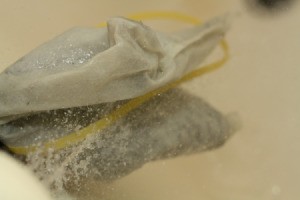
Next, inspect the bag for tears or or holes, particularly around where it is attached to the motor. This is where the bag will receive the most stress over time. Replace the filter bag if you discover any holes.
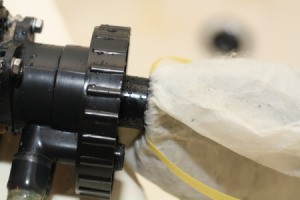
Put a few drops of standard 3-in-1 oil in the oil port. Vortex recommends using their oil, but 3-in-1 is much cheaper and seems to work just fine. It is not necessary to do this every time you use your filter, but if it hasn't been used in a while, it's a good idea. I oil mine every few uses.
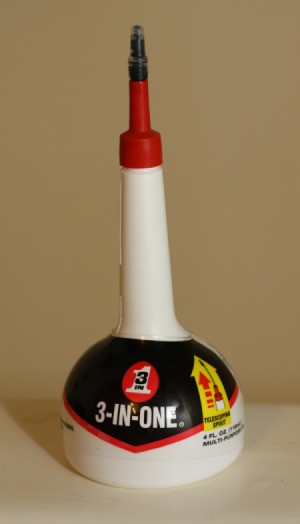

Next, run a bead of Vaseline around the rubber sealing ring. This will help create a water tight seal and extend the life of the rubber gasket. After you have done this once, you will probably only need to do this every other time.

Fill the container with with water.

Insert the filter bag into the container. You will need to fold it slightly to get it through the top. Be sure the yellow strap stays around the bottom of the bag. The strap is helpful in guiding the top part of the bag in. Double check to make sure the corners are all the way down in the bottle. If you get some of the material caught in the gasket, it won't make a good seal.

Thrifty Tip: Older models of Vortex filters came with a glass container. These, as you can imagine, got broken rather often. So, if you purchased one of these older units and the container is broken or missing, you can simply use a standard wide mouth 2 quart Mason jar. The threads are the same.
Set a 5 gallon bucket mostly full of water on a chair or surface of similar height near your fishtank. Put both siphon tubes in the water and set the filter on the floor.
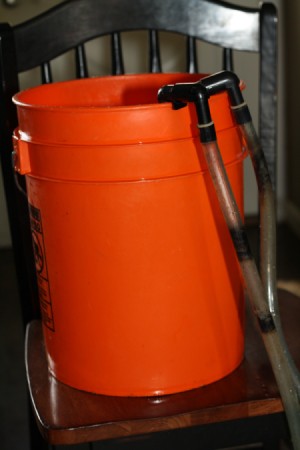
Flip the filter upside down and turn it on. This will create the siphon through the intake tube. The siphon will start immediately so you will only need to have the motor on for a few seconds. I usually turn mine off then turn it right side up, although there is nothing technically wrong with turning back over while it is running.

Turn the unit back right side up and set it up where you will want it to be during the time it is on. I have the Freedom model so I usually hang mine on the door to my fish tank cabinet.

When you turn it back on, water will be running all the way through the system, but there will be some bubbles in the container still. I have found that mine runs more quietly (and presumably more efficiently) if I get rid of these bubbles.

To get rid of these bubbles, simply turn the motor off and they will float up in to the outlet tube. Tilting the unit back slightly so the out tube is facing upward will ensure you get all of them. Now just turn it back on and the motor will push the air out. You will probably never get rid of all the air in the system, but you can do this step a couple times, if necessary. After that your running filter should look like the photo below.
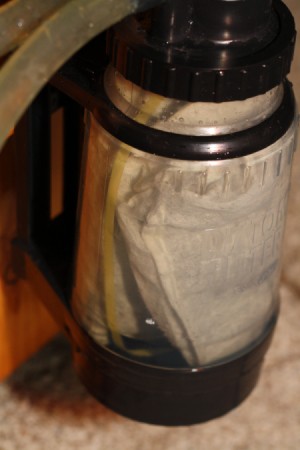
Next you will need to get a small plastic pitcher or some other similar container. Submerge the container in the water and put the tubes in to it. It is important to keep the intake tube below the surface of the water or you will just end up bubbles in the system again. No problem if it does happen, just go back to the previous step. :-)

Keeping the filter tubes in the pitcher, lift it out of the 5 gallon bucket. Now the filter is just turning over that very small amount of water in the pitcher.

Slowly pour 1 cup of diatomaceous earth in to the pitcher. The siphon will suck the powder in and it will quickly coat the filter bag and "charge" the filter.

Thrifty Tip: If you go to your local pool supply store you can purchase a 25 lb. bag of diatomaceous earth for about the same price as a 5 lb. bag from the Vortex company. Unless you are using your diatom filter almost constantly, a 25 lb. bag is pretty much a lifetime supply. There could be trace amounts of chlorine in the diatomaceous earth purchased at pool supply stores. I have never had any issues with this but, just in case, I always add a little water conditioner through the filter before I put it in the tank.

Let the filter run in the pitcher for about 5 minutes. Stir the water up occasionally with the filter tubes to make sure all the powder is sucked up. Continue letting the filter run if the water gets cloudy when you stir it.

At this point, I put about a half a capful of Prime water conditioner in the pitcher to remove any trace amounts of chlorine that may have been in the diatomaceous earth or my tap water.
NOTE: Water conditioners that contain aloe will work just fine for this step but the aloe slime will build up on the filter bag (and any other filter media you are using) even faster than fish slime. Besides, fish don't need aloe in their water.

Once the water is running clear, submerge the pitcher in the fish tank and move the filter tubes in to the tank. Again, be sure to keep the in-take below the surface of the water.
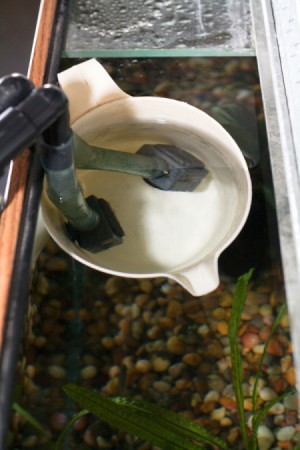
Separate the in-take and output tubes. If they are too close together, you will be pulling water in to the filter that was just filtered. In my tank, there is a glass support that spans the top of the tank. I simply pull the out-put tube up and over this divider to keep the tubes in separate parts of the tank.

Let the filter run for a few hours. You should see a marked improvement in the water clarity. If your water was particularly cloudy before you started, and it isn't clear after running the filter for a few hours, I would recommend doing a 50% water change before running the filter more. A 50% water change is pretty large, but if you are careful to not stir up things too much during the water change, you will be ready to run the diatom filter again.
Once the filter powder reaches a point of saturation, the out-put from the filter will diminish and you will need to re-charge it.
Thrifty Tip: If you are wanting to make sure the diatomaceous earth lasts as long as possible, you can back flush the unit. Simply hook the out-put port up to a faucet and it will force clean water back through the system and most of the particulate will come out the in-put tube. Personally, I don't back flush my unit as I find that recharging it with fresh diatom powder is just as easy. Also, the 25 lb. bag of diatomaceous earth was large and cheap enough that I am not worried about using it up any time soon.
The Vortex motors are designed well and can be run continuously. However, the filter itself is only a physical filter. It does not provide chemical or biological filtration so there is little, if any, benefit from running it more once the water is sufficiently cleared up.
I did have occasion to run mine for a long time (about 2 weeks) when the seal went bad on my canister filter. It ran fine, although it was noisier then my other filter (another reason not to run it all the time). The problem I encountered, however, was my own fault. I did not check the out-put often enough and, after running for that long, the flow slowed to a point that the motor was being worked to hard and it over heated. I nearly killed it, but after a good oiling and getting it set back up again, it still runs great!
By Jess S. from Hillsboro, OR
ThriftyFun - thanks for running this information again as I am getting ready to set up a large aquarium and really appreciate this post.
Betty